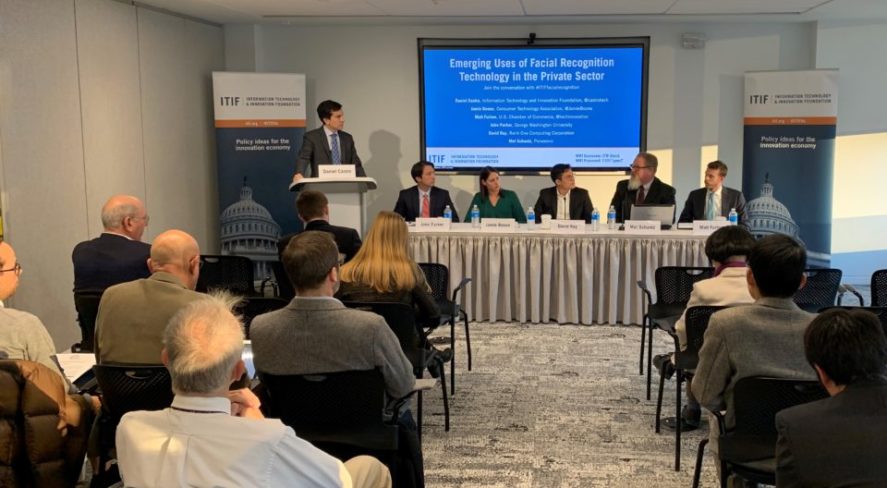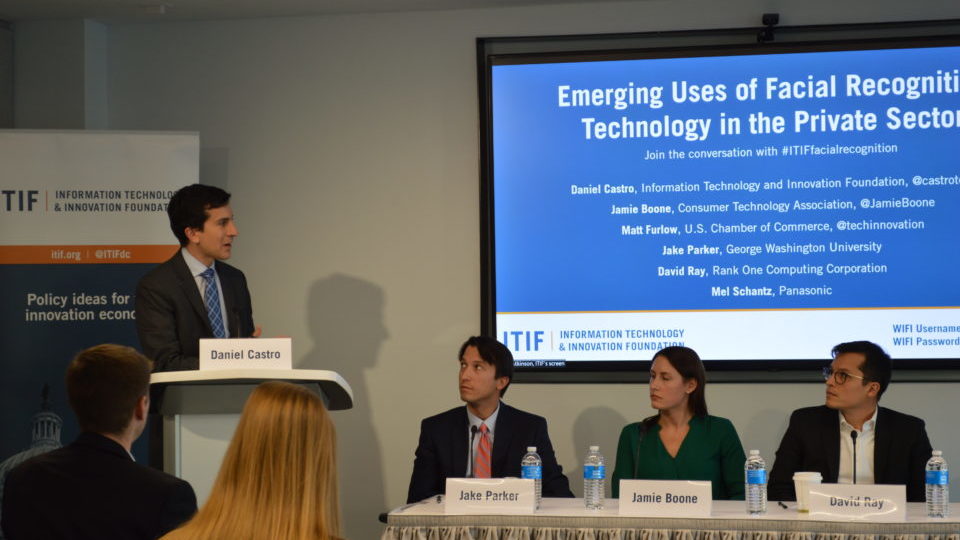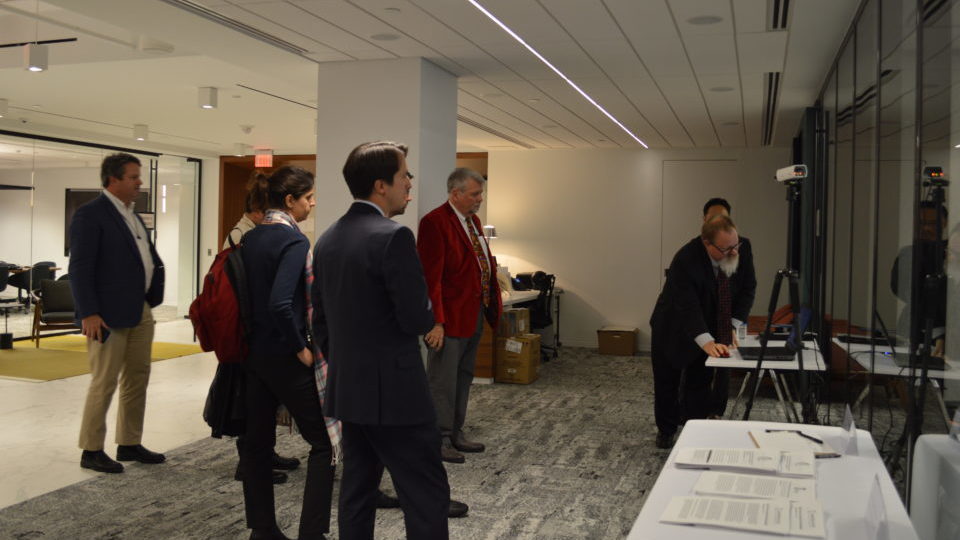Emerging Uses of Facial Recognition Technology in the Private Sector: Highlights From ITIF Briefing

The rapid improvements in the accuracy of facial recognition technology over the past few years have opened up many opportunities for commercial use of the technology. Airlines are using facial recognition technology to expedite boarding, luxury apartment buildings are using facial recognition technology to eliminate the need for residents to carry keys and the hospitality industry is using facial recognition technology to improve customer service. As the technology continues to mature, many different sectors will likely integrate the technology from retail to health care to financial services.
On Dec. 5, the Information Technology and Innovation Foundation (ITIF) hosted a briefing in Washington, D.C., on these emerging uses of facial recognition in the private sector. The discussion – moderated by Daniel Castro, vice president of ITIF and director of the Center for Data Innovation – featured panelists Jamie Boone, vice president of government affairs at the Consumer Technology Association (CTA); Matt Furlow, director of policy, Chamber Technology Engagement Center (C_TEC) at the U.S. Chamber of Commerce; Security Industry Association (SIA) Senior Director of Government Relations Jake Parker; David Ray, chief operating officer and general counsel at Rank One Computing Corporation; and Mel Schantz, supervisor, engineering at Panasonic. These experts explored how industry leaders and policymakers can promote the adoption and use of facial recognition technology in responsible ways, the potential applications of facial recognition technology, industry best practices in the use of the technology and policies that spur innovation and deployment while preserving privacy and security.
First, the panel explored some of the interesting recent applications of facial recognition today; Parker highlighted how the technology can improve access control processes by providing a second factor of authentication in addition to a key card or fob, mitigating tailgating into buildings and more. Boone discussed how, for the first time in 2020, attendees of the popular consumer technology show CES will have the option to use facial recognition in the registration process and how technologies like facial recognition can help speed up processes and shorten wait times and lines. Ray discussed how facial recognition can help consumers prove they are who they say they are when using banking services, Schantz explored the technology’s use in assisted living and health care facilities and Furlow highlighted how facial recognition will move more into the retail space and can be used to personalize and improve customer experiences in hotels and other businesses.
“This is such a great technology for removing pain points in our lives. I hate standing in line – I’m sure everybody hates standing in line, and anything we can do to make that experience better and get people into the things they want to do – this is a great tool to be able to do that,” said Boone.
Next, the speakers discussed how facial recognition technology is advancing and improving. Schantz highlighted how not only are cameras’ imaging capabilities getting better, but so is the technology’s ability to leverage more information (e.g., facial features and points on the face) to better identify people and provide better data for search and analytics.
“Between 2006 and 2017 there’s been a 1,000 times reduction in error rates. It’s continued to improve even since 2017. Facial recognition has arrived; it’s now extremely accurate across all demographics, across all use cases,” said Ray.
Parker discussed how, as a result of technological advances, facial recognition has become more affordable, increasing interest and competition in the space. He also highlighted how facial recognition has advantages over other biometrics because it can provide a touchless experience. Boone explored potential applications of the technology for assisted living facilities and how it could improve quality of life for people with conditions like Alzheimer’s and dementia and looked ahead to how, once driverless cars are widely adopted, ride share services could leverage facial recognition to verify that the correct riders are in each car. Schantz highlighted how facial recognition could help retailers with returning customers to provide VIP experiences for them.
“A good rule of thumb is if you need some sort of authentication, facial recognition could be a solution,” said Furlow.

The panelists then explored the challenge of determining liveness, or whether someone is a real person versus a photograph, and how facial recognition technology is advancing to combat potential attacks. Schantz discussed how industry is working to ensure the technology can tell whether someone is a live person and also make sure the experience is not inconvenient for users.
Next, the panelists discussed privacy and security concerns and deploying the technology in ways that protect users and their information. Furlow highlighted the U.S. Chamber of Commerce’s newly released facial recognition policy principles, which are designed to encourage policymakers to appropriately mitigate any risks associated with the technology with the benefits it provides to consumers and the public. SIA participated in the C_TEC effort that developed these policy principles, which include:
- Prioritize Transparent Use of Facial Recognition Technology
- Protect Privacy and Personal Data
- Promote Beneficial Uses of Facial Recognition Technology While Mitigating Risks
- Pursue a Risk-Based and Use Case-Specific Regulatory Approach
- Establish a Single National Governance and Regulatory Framework
- Support the Development of Risk-Based Performance Standards
- Ensure Federal Investments in Testing and Benchmarking
“We really need to have a single federal framework for facial recognition. We want to see this technology succeed, but we also want to be sure that it’s safe,” said Furlow. “We all have a commitment to make sure it works, it protects consumers and it protects the public as a whole.”
The speakers then addressed responsibility for ensuring secure collection, storage and use of facial recognition data. Ray highlighted that the system user and the system developer both play a role in the security of facial recognition data and the need for a code of ethics for systems developers.
Finally, the panelists explored potential policy solutions and strategies regarding facial recognition. Ray discussed the importance of putting consumer consent at the forefront.
“From a policy perspective, facial recognition is a technology, and it is a tool that, similar to any technology or tool, can be used for good purposes or for harmful or negative purposes. As new technologies come into the marketplace, there is sometimes a level of uncertainty and fear. It’s really important to be careful when we’re making public policy decisions that you’re focused on the action and the user and what the use is rather than regulating on the tool because technology changes all the time… if you legislate on a particular technology, it’s likely going to be outdated very quickly,” said Boone. “Keep in mind the actual problems you’re trying to solve and what you’re trying to prevent. The best way to do that [is] addressing the action rather than the particular technology.”
Schantz discussed how, while it is difficult for companies to control how consumers use their technology, industry can determine where and how the technology gets out and that it is deployed in accordance with laws and policies and work with SIA to help drive policies that help ensure the technology is not completely banned but can work well for our society. Boone also explored how a broader baseline privacy and security law could address concerns with facial recognition.

The event also included a technology demonstration led by Panasonic. Learn more about the briefing here.
For more information on facial recognition technology and its real-world uses, see SIA’s resource Face Facts: Dispelling Common Myths Associated With Facial Recognition Technology.
